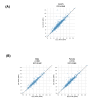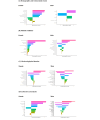Resting Heart Rate and Associations With Clinical Measures From the Project Baseline Health Study: Observational Study
- PMID: 39705694
- PMCID: PMC11699500
- DOI: 10.2196/60493
Resting Heart Rate and Associations With Clinical Measures From the Project Baseline Health Study: Observational Study
Abstract
Background: Though widely used, resting heart rate (RHR), as measured by a wearable device, has not been previously evaluated in a large cohort against a variety of important baseline characteristics.
Objective: This study aimed to assess the validity of the RHR measured by a wearable device compared against the gold standard of ECG (electrocardiography), and assess the relationships between device-measured RHR and a broad range of clinical characteristics.
Methods: The Project Baseline Health Study (PHBS) captured detailed demographic, occupational, social, lifestyle, and clinical data to generate a deeply phenotyped cohort. We selected an analysis cohort within it, which included participants who had RHR determined by both ECG and the Verily Study Watch (VSW). We examined the correlation between these simultaneous RHR measures and assessed the relationship between VSW RHR and a range of baseline characteristics, including demographic, clinical, laboratory, and functional assessments.
Results: From the overall PBHS cohort (N=2502), 875 (35%) participants entered the analysis cohort (mean age 50.9, SD 16.5 years; n=519, 59% female and n=356, 41% male). The mean and SD of VSW RHR was 66.6 (SD 11.2) beats per minute (bpm) for female participants and 64.4 (SD 12.3) bpm for male participants. There was excellent reliability between the two measures of RHR (ECG and VSW) with an intraclass correlation coefficient of 0.946. On univariate analyses, female and male participants had similar baseline characteristics that trended with higher VSW RHR: lack of health care insurance (both P<.05), higher BMI (both P<.001), higher C-reactive protein (both P<.001), presence of type 2 diabetes mellitus (both P<.001) and higher World Health Organization Disability Assessment Schedule (WHODAS) 2.0 score (both P<.001) were associated with higher RHR. On regression analyses, within each domain of baseline characteristics (demographics and socioeconomic status, medical conditions, vitals, physical function, laboratory assessments, and patient-reported outcomes), different characteristics were associated with VSW RHR in female and male participants.
Conclusions: RHR determined by the VSW had an excellent correlation with that determined by ECG. Participants with higher VSW RHR had similar trends in socioeconomic status, medical conditions, vitals, laboratory assessments, physical function, and patient-reported outcomes irrespective of sex. However, within each domain of baseline characteristics, different characteristics were most associated with VSW RHR in female and male participants.
Trial registration: ClinicalTrials.gov NCT03154346; https://clinicaltrials.gov/study/NCT03154346.
Keywords: PBHS; Project Baseline Health Study; Verily Study Watch; cohort study; eHealth; electrocardiogram; electronic health; heart rate; laboratory assessments; medical condition; observational study; physical function; physiology; regression analyses; remote monitoring; resting heart rate; socioeconomic status; vital signs; wearable devices; wearables.
©Kent Y Feng, Sarah A Short, Sohrab Saeb, Megan K Carroll, Christoph B Olivier, Edgar P Simard, Susan Swope, Donna Williams, Julie Eckstrand, Neha Pagidipati, Svati H Shah, Adrian F Hernandez, Kenneth W Mahaffey. Originally published in the Journal of Medical Internet Research (https://www.jmir.org), 20.12.2024.
Conflict of interest statement
Conflicts of Interest: SAS, SS, MKC, and EPS report employment and equity ownership in Verily Life Sciences. KWM reports research grants from Verily, American Heart Association, Apple Inc., Bayer, the California Institute of Regenerative Medicine, Eidos, Gilead, Idorsia, Johnson & Johnson, Luitpold, Pac-12, Precordior, Sanifit; consulting fees from Amgen, Applied Therapeutics, BMS, BridgeBio, Elsevier, Lexicon, Moderna, Sanofi; equity ownership in Precordior, Regencor. The rest of the authors report no relevant disclosures.
Figures





References
-
- Umetani K, Singer DH, McCraty R, Atkinson M. Twenty-four hour time domain heart rate variability and heart rate: relations to age and gender over nine decades. J Am Coll Cardiol. 1998;31(3):593–601. doi: 10.1016/s0735-1097(97)00554-8. https://linkinghub.elsevier.com/retrieve/pii/S0735-1097(97)00554-8 S0735-1097(97)00554-8 - DOI - PubMed
-
- Fox K, Borer JS, Camm AJ, Danchin N, Ferrari R, Lopez Sendon JL, Steg PG, Tardif JC, Tavazzi L, Tendera M, Heart Rate Working Group Resting heart rate in cardiovascular disease. J Am Coll Cardiol. 2007;50(9):823–830. doi: 10.1016/j.jacc.2007.04.079. https://linkinghub.elsevier.com/retrieve/pii/S0735-1097(07)01823-2 S0735-1097(07)01823-2 - DOI - PubMed
-
- Aune D, Ó Hartaigh B, Vatten LJ. Resting heart rate and the risk of type 2 diabetes: a systematic review and dose--response meta-analysis of cohort studies. Nutr Metab Cardiovasc Dis. 2015;25(6):526–534. doi: 10.1016/j.numecd.2015.02.008. http://hdl.handle.net/10044/1/32399 S0939-4753(15)00051-4 - DOI - PubMed
-
- Aune D, Sen A, ó'Hartaigh B, Janszky I, Romundstad PR, Tonstad S, Vatten LJ. Resting heart rate and the risk of cardiovascular disease, total cancer, and all-cause mortality - a systematic review and dose-response meta-analysis of prospective studies. Nutr Metab Cardiovasc Dis. 2017;27(6):504–517. doi: 10.1016/j.numecd.2017.04.004. http://hdl.handle.net/10044/1/49542 S0939-4753(17)30085-6 - DOI - PubMed
-
- Perez MV, Mahaffey KW, Hedlin H, Rumsfeld JS, Garcia A, Ferris T, Balasubramanian V, Russo AM, Rajmane A, Cheung L, Hung G, Lee J, Kowey P, Talati N, Nag D, Gummidipundi SE, Beatty A, Hills MT, Desai S, Granger CB, Desai M, Turakhia MP, Apple Heart Study Investigators Large-scale assessment of a smartwatch to identify atrial fibrillation. N Engl J Med. 2019;381(20):1909–1917. doi: 10.1056/NEJMoa1901183. https://europepmc.org/abstract/MED/31722151 - DOI - PMC - PubMed
Publication types
MeSH terms
Associated data
LinkOut - more resources
Full Text Sources
Medical
Research Materials

